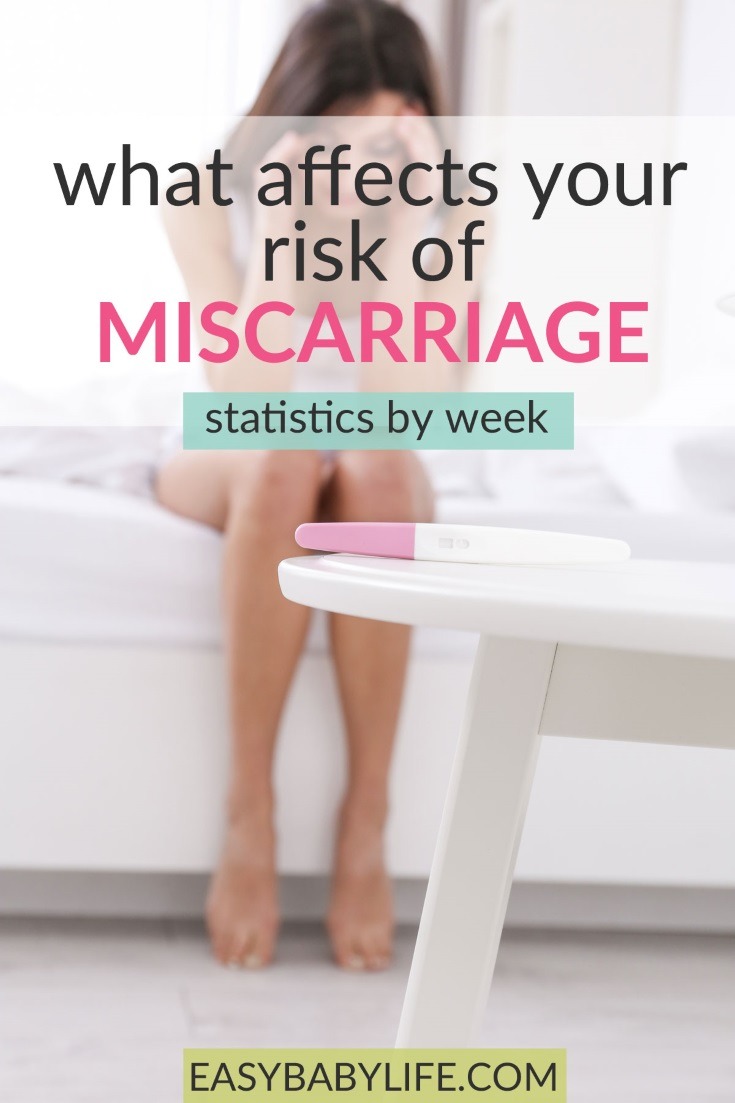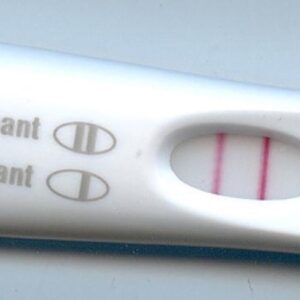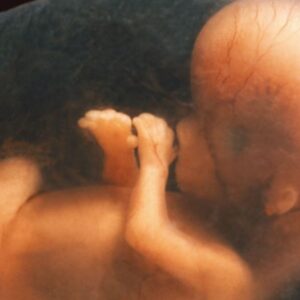
Are you possibly scanning the Internet for miscarriage statistics..?
The risk of miscarriage is one of the greatest worries for women in early pregnancy. While the numbers can be sobering, it is also reassuring to see how quickly the risk falls as pregnancy progresses. Most pregnancies are successful, and many early miscarriages occur before a woman even realizes she was pregnant.
This article brings together research-based statistics on miscarriage by week of pregnancy, as well as by maternal age, recurrent miscarriages, and lifestyle factors. My hope is that these numbers provide both clarity and comfort, especially if you are currently pregnant or have experienced a loss in the past.
In this article…
- My story
- How common is miscarriage?
- Miscarriage statistics by week 3 and on
- Why the early high percentages can be misleading
- Recurrent miscarriage risk
- Maternal age and miscarriage risk
- Paternal age and miscarriage risk
- Other factors affecting pregnancy outcome
- When is it safe to try again?
My story
After six months of trying, we finally conceived—only to miscarry in the fifth week of pregnancy. What followed was a long and emotionally exhausting period of looking for ovulation symptoms, BBT chartingtiming intimacy, and hoping. Nine months later, I became pregnant again, but the anxiety was overwhelming.
At week 8, I experienced bleeding and panicked. My midwife scheduled an early ultrasound. Seeing my baby’s tiny heartbeat was magical and gave me some relief, but I still counted down the days until week 12. In those early weeks, I spent countless hours online searching for miscarriage statistics.
If you’re feeling anxious like I was, I hope this article saves you time and gives you clarity. At the end, you’ll find research-based answers on when it’s safe to try again after a miscarriage, plus links to further reading and comments by parents who have experienced miscarriage or are worried about it.
How Common Is Miscarriage?
Miscarriage is more common than many realize. In high-income countries (the most recent study), about 12–24% of recognized pregnancies end in miscarriage, depending on how it is measured (Schummers et al., 2021). The true number is likely higher, since many very early miscarriages happen before a pregnancy test would even be positive. What might look like a slightly late or heavy period could in fact have been an early pregnancy loss.
Miscarriage Statistics By Week
Research shows that miscarriage risk changes rapidly during early pregnancy. The general pattern is reassuring: the further you progress, the lower the risk becomes.
- In the earliest weeks (3–4), miscarriage is most common, with estimates ranging from 22% to 75%. These numbers largely reflect chemical pregnancies—losses that occur before implantation is complete.
- By weeks 5–6, the outlook is already much better. The overall miscarriage risk during this period is about 10%, and it continues to drop with each passing week.
- By week 9, the risk is around 5%.
The decline is even sharper if an ultrasound confirms a live embryo with a heartbeat. In asymptomatic women, once a heartbeat is seen, the likelihood of miscarriage becomes very small: about 9% at week 6, 4% at week 7, and 1.5% at week 8. By week 9–10, the risk is less than 1% (Tong et al., 2008).
Modern studies confirm this pattern and refine how clinicians interpret early ultrasounds:
- Doubilet et al., NEJM 2013 updated diagnostic criteria for early pregnancy failure, ensuring viable pregnancies are not misclassified.
- DeVilbiss et al., 2020 showed that specific ultrasound findings (such as unusually low fetal heart rate or crown–rump length) can indicate higher risk, even when a heartbeat is present.
Miscarriage Risk by Week of Pregnancy
“Week” refers to completed gestational weeks, “All” refers to all pregnancies, and “Heartbeat” refers to asymptomatic women with a heartbeat, hence a live embryo confirmed on ultrasound.
Figures are approximate and based on large cohort studies.
| Week | All | Heartbeat |
|---|---|---|
| 3–4 weeks | 22–75% | — |
| 5–8 weeks | ~10% | — |
| 6 weeks | — | ~9.4% |
| 7 weeks | — | ~4.2% |
| 8 weeks | — | ~1.5% |
| 9 weeks | — | ~0.5% |
| 10 weeks | — | ~0.7% |
| 8–14 weeks | ~5% | — |
| 14–20 weeks | ~1–2% | — |
Context updated with Doubilet PM et al., NEJM 2013; DeVilbiss EA et al., 2020.
Note: After 20 weeks (US) or 24 weeks (UK), pregnancy loss is classified as stillbirth.
Stillbirth risk in high-income countries is ~0.3–0.5% (WHO 2020; ACOG 2020).
Beyond Week 20
Note: After 20 weeks in the US (or 24 weeks in the UK), the term miscarriage is no longer used. Losses from this point are classified as stillbirths.
Stillbirth is rare: in high-income countries, it occurs in about 0.3–0.5% of pregnancies (WHO, 2020; ACOG, 2020). Knowing this distinction can help parents understand that while miscarriage risk falls dramatically after the first trimester, the risk of pregnancy loss never disappears completely, but it is very low.
Why the early high percentages can be misleading
At first glance, the figure of 22–75% risk in weeks 3–4 can feel alarming. But it’s important to understand what it represents. Most of these very early losses occur before implantation, or in pregnancies with severe chromosomal abnormalities that could never continue.
Many of these cases would simply look like a slightly late period. That is why doctors sometimes prefer to separate chemical pregnancies from miscarriages detected after a positive test.
For women who already have a positive pregnancy test and no concerning symptoms, the actual risk is usually much lower than those very early numbers suggest.
I guess my first pregnancy (and miscarriage) was a textbook example of a chemical pregnancy. Most women probably won’t even know they were pregnant, but I knew since we actively tried to conceive, and I was tracking my basal body temperature very closely.
If I were you, I wouldn’t worry too much about the terrible statistics for the first few weeks. The data is highly uncertain, and if you do miscarry, i) chances are you won’t even know that you were (chemically) pregnant, and ii) it is likely that the miscarriage was due to chromosomal abnormalities that made your body stop the pregnancy.

Recurrent miscarriages
The statistics above reflect the risk of a first miscarriage. But what happens if you have experienced more than one?
Doctors use the term recurrent miscarriage when a woman has lost two or more pregnancies. This is much less common than a single miscarriage. Fewer than 5% of women experience two in a row, and only about 1% experience three or more.
If you’ve gone through two losses, many guidelines now recommend talking with your doctor about an evaluation. In the past, testing often didn’t begin until after three miscarriages, but recent research shows that starting sooner can sometimes provide answers or reassurance.
Here’s the part most couples need to hear: the outlook is still hopeful.
- Even after two or three miscarriages, many women go on to carry a healthy pregnancy.
- Studies show that long-term live birth rates after recurrent miscarriage range between 60–75%, depending on age and history.
- If a treatable conditions are found, medication during pregnancy can improve the chances further.
Bottom line: If you’ve had two losses, don’t lose hope. It may be time for a medical work-up, but the odds of eventually welcoming a baby are still in your favor.
Maternal Age and Miscarriage
Maternal age is one of the clearest factors influencing miscarriage risk. A large Norwegian study (BMJ 2019) analyzed over 400,000 pregnancies and found:
- Women in their late 20s had the lowest risk (around 9–10%).
- Risk begins to rise after 30, reaching 16.7% at ages 35–39.
- At 40–44, the risk was about 32%.
- At 45 and older, more than half of recognized pregnancies ended in miscarriage (53.6%).
These numbers reflect all recognized pregnancies, not just those reaching an early scan. Importantly, even for women over 40, many pregnancies still progress successfully, especially if a heartbeat is seen.
Miscarriage Risk by Maternal Age (all recognized pregnancies)
| Maternal Age | Risk of Miscarriage |
|---|---|
| <20 | 15.8% |
| 20–24 | 11.2% |
| 25–29 | 9.8% |
| 30–34 | 10.8% |
| 35–39 | 16.7% |
| 40–44 | 32.2% |
| ≥45 | 53.6% |
Role of maternal age and pregnancy history in risk of miscarriage: prospective register-based study.
BMJ 2019;364:l869.
Paternal Age and Miscarriage
While maternal age remains the strongest age-related factor, research also shows a modest, independent effect of paternal age on miscarriage, especially in the first trimester. A 2020 systematic review and meta-analysis found that, compared with fathers aged 25–29 (reference), the risk of spontaneous miscarriage increases with advancing paternal age, reaching about 1.23× at 40–44 and 1.43× at ≥45; for first-trimester miscarriages, the ≥45 group rose to ~1.74× the risk, even after adjusting for maternal age.
PubMed
How to interpret this: paternal age has a smaller effect than maternal age, but it’s not zero. The absolute risk you see in real life will still be driven largely by maternal age, while paternal age adds a modest increase.
Paternal Age and Relative Risk of Miscarriage
| Paternal Age | Relative Risk vs. 25–29 |
|---|---|
| 30–34 | ~1.04 (95% CI 0.90–1.21) |
| 35–39 | ~1.15 (0.92–1.43) |
| 40–44 | ~1.23 (1.06–1.43) |
| ≥45 | ~1.43 (1.13–1.81) |
For first-trimester miscarriages specifically, ≥45 years showed ~1.74× risk.
Other Factors Affecting Pregnancy Outcome
Research also shows that certain lifestyle and health factors can affect miscarriage risk:
- Smoking and heavy alcohol use are linked with increased risk.
- Caffeine should be limited to ≤200 mg per day (about one medium cup of brewed coffee).
- Weight plays a role: both obesity (BMI >30) and being underweight (BMI <18.5) may raise the risk.
- Stress is often blamed, but everyday stress has not been shown to cause miscarriage. Only extreme, prolonged traumatic stress may have some effect.
- Medical conditions like uncontrolled diabetes, thyroid disease, or autoimmune disorders can increase risk, but with treatment and monitoring, risks are much lower.
The reassuring takeaway is that many risk factors are manageable. Quitting smoking, reducing alcohol, managing weight, and treating medical conditions can all help support a healthy pregnancy. Find in-depth information on the causes of miscarriage here.
When is it safe to try again?
One of the most common questions after a loss is “How long should we wait before trying again?”
If the miscarriage was early and without complications, research shows you don’t need to delay. Ovulation can return within two weeks, and most women have their next period in 4–6 weeks. Many doctors suggest waiting for one normal cycle mainly to make dating the next pregnancy easier, not because it is medically necessary.
Large studies have found that couples who tried again within 3–6 months were actually more likely to conceive and have a healthy live birth compared with those who waited longer. In high-income settings, there is no evidence that trying again soon increases the risk of miscarriage or complications.
There are exceptions: if you had a D&C, heavy bleeding, infection, a second-trimester loss, ectopic, or molar pregnancy, your doctor may advise waiting longer. And if you’ve experienced two or more miscarriages in a row, it’s worth asking for an evaluation before trying again.
The emotional side matters just as much. Some people feel ready right away, others need more time. Either choice is okay. What can help is starting a prenatal vitamin with folate, and, if anxiety is high, asking for an early reassurance scan around week 8–9 in the next pregnancy.
You can read more about getting pregnant after miscarriage in this article.
Conclusion
Miscarriages happen whether we worry or not. Most of the time, they don’t. Trying to let go of the worrying will make your life in early pregnancy happier and may even actually reduce the risk of miscarriage a little bit. (I know, A LOT easier said than done..!)
If you are very worried, ask for an early ultrasound scan. By week 9, the chance of miscarriage is less than 1% if a live embryo is visible. By the second trimester, miscarriage becomes rare.
Remember that by the time you have a positive pregnancy test, the highest risk of miscarriage is already behind you.
While maternal age and certain health or lifestyle factors can increase risk, the overall picture is reassuring: most pregnancies result in a healthy baby.
If you have experienced a miscarriage, remember it is rarely caused by anything you did or didn’t do. And if you are pregnant now, every week that passes lowers the risk and brings you closer to meeting your baby.
I hope you found this information on miscarriage statistics useful. Feel free to share any thoughts by leaving a comment below.
Read Next
- What Can Cause A Miscarriage – And Not
- Can Stress Cause Miscarriage? Maybe, Research Says
- Getting Pregnant After Miscarriage
- Early and Late Bleeding During Pregnancy
- Signs and Symptoms of Miscarriage: What’s Normal and When to Get Help

References
- Wilcox AJ, Weinberg CR, O’Connor JF, et al. Incidence of early loss of pregnancy. N Engl J Med. 1988;319(4):189–94.
- Tong S, Kaur A, Walker SP, et al. Miscarriage risk for asymptomatic women after a normal first-trimester prenatal visit. Obstet Gynecol. 2008;111(3):710–4.
- Doubilet PM, Benson CB, Bourne T, et al. Diagnostic criteria for nonviable pregnancy early in the first trimester. N Engl J Med. 2013;369:1443–51.
- Magnus MC, Wilcox AJ, Morken N-H, Weinberg CR, Håberg SE. Role of maternal age and pregnancy history in risk of miscarriage: prospective register-based study. BMJ. 2019;364:l869.
- DeVilbiss EA, et al. Trends in risk of pregnancy loss among US women, 1990–2011. Paediatr Perinat Epidemiol. 2020;34(6):678–87.
- World Health Organization. Stillbirths (global estimates and definitions). 2020.
- American College of Obstetricians and Gynecologists (ACOG). Management of Stillbirth. 2020.
- Wilcox AJ, Weinberg CR, O’Connor JF, et al. Incidence of early loss of pregnancy. N Engl J Med. Jul 28, 1988;319(4):189-94.
- Allison JL, Schust DJ., Recurrent first-trimester pregnancy loss: revised definitions and novel causes. Curr Opin Endocrinol Diabetes Obes. 2009 Dec;16(6):446-50.
- Maternal age and fetal loss: population based register linkage study
- Miscarriage information by Mayo Clinic

Paula Dennholt founded Easy Baby Life in 2006 and has been a passionate parenting and pregnancy writer since then. Her parenting approach and writing are based on studies in cognitive-behavioral models and therapy for children and her experience as a mother and stepmother. Life as a parent has convinced her of how crucial it is to put relationships before rules. She strongly believes in positive parenting and a science-based approach.
Paula cooperates with a team of pediatricians who assist in reviewing and writing articles.







thanks for sharing such beautiful information with us. I hope you will share some more information about infertility treatment. please Keep sharing
So I really appreciate the statistics and break down of data, I’m currently pregnant with our second. However, some of your wording is off. Your little girl didn’t suddenly become your daughter when she was born, she was when she was created. And a “live embryo” is an alive baby within the womb. It’s important to recognize they are human beings before birth as well
Hi Lydia, I had to go back and read my post to try to find the sentence you refer to. And I see what you mean. I didn’t mean that she wasn’t my daughter during the first early ultra scan, just that I didn’t know who she was. To me, she was very much alive and real. It was an amazing moment. Thanks a lot for the heads up and I’ve changed the wording.
Huge good luck with your pregnancy! I’m glad you found the stats helpful. How many weeks pregnant are you?
I am currently 4weeks and 3 days and only found out 2 days ago that I am pregnant again. I honestly didn’t think I would so fast. I miscarried only 2 month ago and this was my first normal cycle after miscarriage. I am terrified of having another miscarriage.. but this article really does pit my mind at ease for the most part. Thank you!!
I appreciate this post so much! It was so helpful to me when I found out I was pregnant with my first baby at 4 weeks and 2 days and had bleeding at 6 weeks. I read your post many times from week 6 to 13 and now have a wonderful one year old boy. I just had another positive pregnancy test at exactly 4 weeks and have already pulled it up as a refresher again.
Thank you, this article has made me feel a little more relaxed. Very informative 😊 xx
Thank you for your help. I’m quite nervous and just I read and I quote, Remember that by the time you have a positive pregnancy test, the highest risk of miscarriage is already behind you. Isn’t that great to know. Are you referring to a take home pregnancy test? If so then this might help ease my nerves.
Thank you!
Hi Lauren! How are things going? Great, I hope!
Thanks so much for this article. I had my first at 39 and am now pregnant again at 42. We conceived fairly quickly but it was quite an effort due to some issues on my husband’s side. I’m very nervous but it’s good to be informed. I’m hanging for my 10week ultrasound. My OB is away for the two weeks before. Fingers crossed!
Thankyou for writing this. I am 4 1/2 weeks
And trying not to worry this article is very helpful x
I have nominated you for the blogger recognition award! https://lovelifelaughmotherhood.com/2017/05/blogger-recognition-award-2017/
Oh sweet, thank you so much! <3
An amazing article! Thank you for sharing your experience and knowledge that you gained. Insightful and comforting.
Thank you, Sarah! Which week are you in? Crossing my fingers for you!
The wording is wrong here: “According to these figures, the risk of miscarriage right after conception is very high.” No, the risk of miscarriage right after conception is low. Only 10-20% of all pregnancies end in miscarriage. According to the figures shown, the majority of those 10-20% miscarriages take place in those first weeks. Be careful with scaring people.
Thank you German, you’re correct – the overall risk of a miscarriage is low, but the risk is the highest during those first few weeks. Thanks for pointing out how the wording can be misunderstood! I’ll change it!
But you didn’t change it ^^
Thanks for the reminder. Updated! :-)
I am crossing my fingers for you, Kim! Let me know how things go!
Thanks for this. I’m 5 weeks 5 days along and I wasn’t sure if I should even bother calling my doctor because I thought I’d just have another miscarriage (given I had one a few months ago at 14 weeks). I thought the percentage at my stage of pregnancy was a lot higher but the 10% isn’t that high at all.
And good luck to you, Kat!! I had exactly the same situation as you – spotting in the early weeks. Up until week 10 or 12, I think. Extremely scary, but it went well. Crossing my fingers for you!
So happy I came across your post. Thank you so much for sharing this information. I dont think Ive ever been so concerned or worried about anything in my life and I really just want to know that everything is okay. Thanks again!
I know, Ashleigh, it can be torture to wait and hope during the first three months… I truly wish you good luck with your pregnancy! :-)
Hello, I realize that these comments on the article are a couple years old…but if anyone is there then I have a question (:
I am 10w pregnant right now…and last week I had some major bleeding. The dr took me in for an u/s and found a healthy heart beat and no bleeding up in the uterus or around baby. The bleeding was on the cervix and was most likely due to sex/orgasm.
Does this mean that my chances of miscarriage are still less than 1% since the bleeding isn’t up in the uterus, but only on the cervix? The dr told me that the reason I probably bled is because there is a bunch of new veins up there and an increased blood flow. Or are my chances of a miscarriage different since I was bleeding when I had the u/s?
Hi Jilian, bleeding in pregnancy is pure torture! Poor you! But if your Dr told you that the bleeding was not in the uterus and there was a healthy heartbeat, you should probably just rely on you Dr and consider your risk of miscarriage the same as for anyone else who has already found a healthy heartbeat… A very good sign! Please let me know how things proceed. When is your due date?
Best, Paula
Hi Kayleigh, I truly hope the spotting was just implanting, just as your doctor said. How are you doing? Spotting is difficult, It doesn’t have to mean anything, but it can. I think you are doing exactly the right thing – bothering your doctor when you feel that you need to. Crossing my fingers for you!
Thank you so much for this article. As this is my 1st pregnancy at 38 I have been worried every second of the day about this. I entered my 9 weeks today and so far all signs point to good. Just so helpful to know I am not alone in the worrying.
I had an ultrasound at 6 weeks, heart rate was perfect, everything was great, all hcg and progesterone levels were in line, no spotting, no cramping, no issues at all, went in for my 12 week appointment and the baby’s heart had stopped beating at 11 weeks and 5 days. I guess my point is that no matter how much research we do there is always a chance, worry will not help us prevent a miscarriage though either. We all just have to have faith and hope and a great support system that will help us get through.
Thank you very much for this information. I miscarried back in October and am now 6 weeks pregnant and trying not to worry too much. This has been really helpful, thank you.
Yes! Maybe I can relax now, I am SO worried that because of my age (37) , that I will miscarry, when It’s a shock to me that we even conceived at all. But to know that the majority of the risk is already behind us, makes me so grateful. Ty ty ty! For sharing this info. :D I’m not going to be afraid to bond for fear of loss.
That’s great to hear! I truly hope you will have no problems at all. Congratulations on your pregnancy.
Thank you for compiling this information. Very helpful article :)
Thanks a lot Erin! :-)